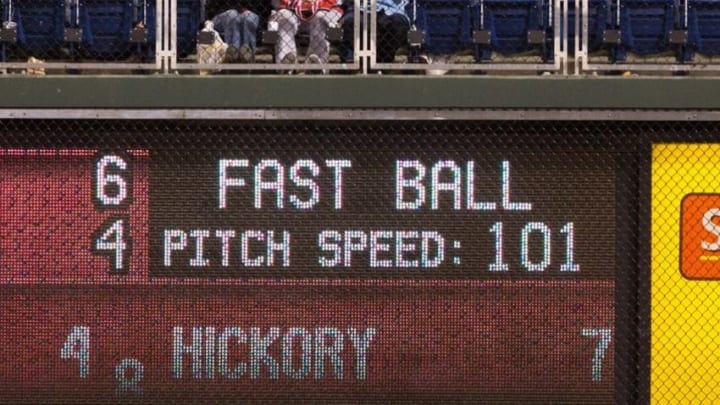Billy Wagner: The Forgotten Relief Ace
By Adam Tabakin

Billy Wagner may not be worthy of the Hall of Fame, but his case deserves more consideration than it’s currently getting.
Let’s play a game. Given the career statistics of two relief pitchers, can you pick out which player is on the verge of making the Hall of Fame and which player is on the verge of falling off the ballot altogether?
Player A – 903 IP, 2.31 ERA, 2.73 FIP, 187 ERA+, 0.998 WHIP, 1196 K, 27.7 bWAR
Player B – 1089.1 IP, 2.87 ERA, 3.08 FIP, 141 ERA+, 1.058 WHIP, 1133 K, 28.0 bWAR
Player A appears to have been more dominant. He had much better ratios and rate statistics, including a far better adjusted ERA. On the other hand, Player B threw significantly more innings, a result of starting his career almost three full seasons before Player A. Each has his advantages over the other, but one was named on 67.3% of ballots in last year’s Hall of Fame voting while the other was named on just 10.5% of ballots.
Oh yeah… Player A had 422 saves while Player B had 601 saves.
Essentially you have one statistic accounting for a 56.8% difference between Trevor Hoffman (Player B) and Billy Wagner (Player A). As of Monday night, that difference has grown to 60.4% in this year’s balloting, according to Ryan Thibodaux’s Hall of Fame tracker. Hoffman is a scant few percentage points away from election with just over a third of all ballots accounted for. Meanwhile, Wagner is just fighting to stay in double digits for the second straight year.
Two groups of players are in question here: pitchers who spend their entire career working in relief, and pitchers who belong in the Hall of Fame. Mariano Rivera stands alone at the intersection of those groups, as relief pitchers simply don’t play enough to have as much of an effect on a game as starters who throw three times as many innings over the course of a season. For a more detailed argument against relief pitchers, please refer to Bobby Mueller’s column from last week.
More from Call to the Pen
- Philadelphia Phillies, ready for a stretch run, bomb St. Louis Cardinals
- Philadelphia Phillies: The 4 players on the franchise’s Mount Rushmore
- Boston Red Sox fans should be upset over Mookie Betts’ comment
- Analyzing the Boston Red Sox trade for Dave Henderson and Spike Owen
- 2023 MLB postseason likely to have a strange look without Yankees, Red Sox, Cardinals
The reality, though, is that there are a few other relief pitchers in the Hall of Fame, and there will probably be more to come. If Trevor Hoffman is so close to induction, why does Billy Wagner fall so short? Yes, Hoffman pitched 186.1 more innings. However, the difference in those 186.1 innings pitched is a 5.55 ERA and a 1.35 WHIP, and Wagner still struck out more batters than Hoffman. Put another way, to get to Trevor Hoffman’s career, you have to add a season of bad Jamie Moyer to Billy Wagner. For some reason, that additional bad baseball makes Hoffman more valuable.
Of course, we have all become victims of the save statistic. The same statistic that prevented Buck Showalter from using Zach Britton in the AL Wild Card game this past October. The statistic that says a pitcher who gives up two runs in an inning while protecting a three-run lead is more important than a pitcher who throws two perfect innings in a tie game. This statistic is the only reason Hoffman is a virtual lock to make the Hall of Fame in the next couple years while Wagner will be almost an afterthought.
Hoffman entered in the ninth inning to a mediocre classic rock song. Wagner entered in the ninth inning to a 100 mph fastball in the days before every major league bullpen had two players who could touch that velocity. Dealing from a 5-foot-10 frame, Wagner set a record in 1997 by striking out 14.4 batters per nine innings pitched for the Houston Astros. He broke that record in 1998. He broke it again in 1999. That mark has been topped several times in the past decade, but for an extended period, the most feared reliever in baseball stood a full foot shorter than the most feared starter in baseball, Wagner’s one-time teammate Randy Johnson.
Wagner retired after the 2010 season shortly after turning 39 to spend more time with his family. In that last season with the Atlanta Braves, Wagner posted a career-low ERA of 1.43 and struck out more than 100 batters for the fourth time in his career. Yes, he also saved 37 games. Unlike Hoffman, who struggled through a 5.89 ERA in 2010 just to reach the artificial 600-save milestone, Wagner went out on top.
Billy Wagner is not a Hall of Famer. But his case is stronger than Trevor Hoffman’s.